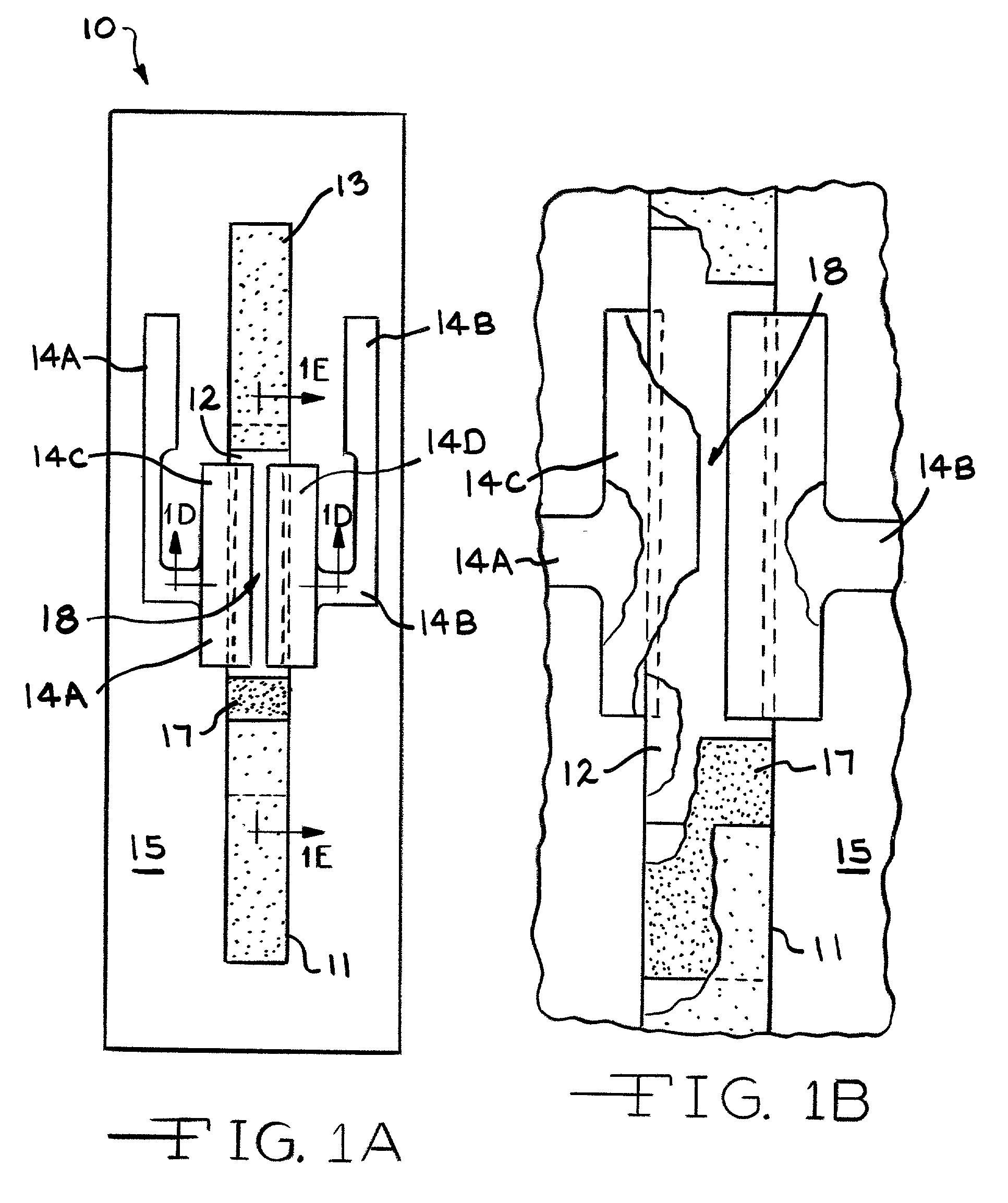Conductimetric biosensor device, method and system
a biosensor and biosensor technology, applied in the direction of fluid pressure measurement, liquid/fluent solid measurement, peptide measurement, etc., can solve the problem that no prior art uses a capture reagent labeled with a conductive polymer in sandwich type assays, and achieves easy miniaturization, reliable detection of analyte, and economic production
- Summary
- Abstract
- Description
- Claims
- Application Information
AI Technical Summary
Benefits of technology
Problems solved by technology
Method used
Image
Examples
example 1
[0071] 1.1 Reagents:
[0072] Aniline, glutaraldehyde, N,N Dimethylformamide (DMF), Tween-20, tris buffer, phosphate buffer, phosphate buffer saline (PBS) were purchased from Sigma-Aldrich (Missouri). Antibodies (Rabbit anti-E. Coli O157:H7) were obtained from Biodesign (Maine). Nitrocellulose (NC) membrane 12 with 8 .mu.m pore size and flow rate of 160 sec per 4 cm, and cellulose membrane 13 were purchased from Millipore (Massachusetts). Fiber-glass membrane 11 grade G6 were also obtained from Millipore. Silver Kwik-stik pen for electrodes 14C and 14D was supplied from SPI (Pennsylvania). Other reagents used were of analytical grade. All chemicals and diluents were prepared with doubly deionized water with conductivity below 0.1 .mu.S / cm.
[0073] Antibody Labeling with Polyaniline
[0074] A water-soluble polyaniline was synthesized by following a standard procedure of oxidative polymerization of aniline monomer in the presence of ammonium persulfate (Kim et al, previously discussed). A mi...
example 2
[0084] Construction of Multi-Array
[0085] More than one capture zone is designed on the NC capture membrane 20 as shown in FIG. 3, thus, multiple types of antibodies with different specificity can be immobilized on the membrane 20. FIG. 3 shows the design of the capture or signal region 23 with multiple regions 21A to 21D for antibody immobilization between electrodes 22A to 22E. As shown in FIG. 4, after sample application, the biosensor device 10 is inserted into the strip box 30. The lead wire 31 attached to the side of the box 30 induces a constant current from the power supply 32. The current flows across the capture or signal region 23 and generates a voltage signal 33, which is proportional to the changes of the resistance. The generated voltages are transferred through a circuit box 34 and stored in the computer 35 via the data acquisition 36.
[0086] Thus the present invention:
[0087] 1. Reduces the distance between electrodes to preferably less than 500 .mu.m in order to incre...
example 3
[0090] The base construction of biosensor device 10 is shown in FIG. 5. The gap 18 was 5 mm inside.times.30 mm long. The polyaniline membrane 17 (dotted lines) with the conjugated antibody was 10 mm long.times.5 mm wide in the gap 18. The sample membrane 11 was fiber glass and measured 5 mm wide and 10 mm long.
EXAMPLE 4
[0091] The device 10 was prepared as follows:
[0092] Procedure:
[0093] 1. Construction of the Analytical Systems
[0094] 1. Prepared the model as shown in FIG. 1B above using nitrocellulose (NC) membrane 12 from Millipore (Massachusetts).
[0095] 2. Immobilized the Antibody
[0096] 1. The membrane 12 was washed 3 times with distilled water, then treated with 10% (v / v) methanol for 30 minutes and left to dry.
[0097] Prep:
[0098] Nitrocellulose (NC) membranes were cut in to the smaller pieces (6-7 cm) to fit a petri dish. 10 ml methanol is dissolved in 100 ml of distilled water.
[0099] 2. The surfaces were modified by immersing them in 0.5% (v / v) glutaraldehyde sol for 1 hour and ...
PUM
| Property | Measurement | Unit |
|---|---|---|
| width | aaaaa | aaaaa |
| Size | aaaaa | aaaaa |
| pore size | aaaaa | aaaaa |
Abstract
Description
Claims
Application Information
 Login to View More
Login to View More - R&D
- Intellectual Property
- Life Sciences
- Materials
- Tech Scout
- Unparalleled Data Quality
- Higher Quality Content
- 60% Fewer Hallucinations
Browse by: Latest US Patents, China's latest patents, Technical Efficacy Thesaurus, Application Domain, Technology Topic, Popular Technical Reports.
© 2025 PatSnap. All rights reserved.Legal|Privacy policy|Modern Slavery Act Transparency Statement|Sitemap|About US| Contact US: help@patsnap.com



